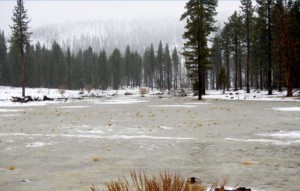Snowpack improving, but not fast enough

A wet February in Lake Tahoe has improved the overall water picture, but not enough to end the drought. Photo/LTN
By Kathryn Reed
Maybe the Department of Water Resources ought to schedule snow surveys more often because snow fell each of the last two times.
While every drop of moisture helps, California is not likely to get out of its drought this season. Still, things are slightly improved, but still worrisome.
Statewide, the water content on Feb. 27 was 24 percent of average for the date. On Echo Summit near the entrance of Sierra-at-Tahoe the story was a little better. The 25.7 inches of snow have a water content of 8.1 inches, which is 33 percent of normal.
A month ago, statewide the water content was 12 percent of normal and the Echo reading was 7 percent.
“We welcome the late storms, but they are not enough to end the drought,” DWR Director Mark Cowin said in a statement. “We can’t control the weather, but we can control the amount of water we use. This drought is a wake-up call that we all have to take water conservation seriously and make it a way of life.”
This is the third consecutive dry winter for California. The snowpack normally provides about a third of the water used by cities and farms as it melts into streams and reservoirs in spring and early summer. The reservoirs store the water for famers and municipalities. But without snow there is nothing to store.
Lake Oroville, the State Water Project’s principal reservoir, is at 39 percent of its 3.5 million acre-foot capacity. Normally it is at 57 percent this time of year. Shasta Lake, California and the federal Central Valley Project’s largest reservoir, is at 38 percent when it should be at 52 percent.
And with the lack of storage, the end users are not getting what they expect or need. Some cities in California have invoked water restrictions. Farmers are leaving fields fallow. Only water for health and safety reasons will be delivered from the State Water Project.
January and February are typically the wet months in the Sierra. While a Miracle March could happen, it can’t make up for three years of below normal snow and rain.
February will end on a wet note. The National Weather Service in Reno is calling for a 100 percent chance of snow in Lake Tahoe.
Also on Thursday, the Legislature sent Gov. Jerry Brown a $687 million drought relief package. Much of the money would come from bond money that has not been spent. Most of the money — $500 million – would be allocated for communities to build systems to capture stormwater and then use the grey water. Money is also available for communities if they run out of potable water.


